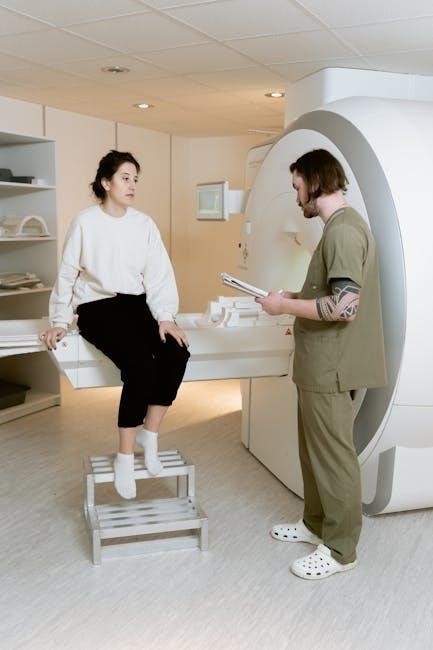The Peabody Assessment is a comprehensive tool for evaluating motor skills in children from birth to 5 years, providing standardized measures for early childhood development.
1.1 Overview of the Peabody Developmental Motor Scales (PDMS)
The Peabody Developmental Motor Scales (PDMS) are a widely used assessment tool designed to evaluate motor skills in children from birth to 5 years. It assesses both gross and fine motor abilities, providing a comprehensive understanding of a child’s developmental progress. The PDMS includes standardized tests to measure skills like reflexes, balance, coordination, and object manipulation, ensuring reliable and consistent results.
The assessment is available in two editions, PDMS-2 and PDMS-3, with updated criteria and expanded age ranges for better accuracy. The detailed manual guides examiners through administration and scoring, making it a valuable resource for professionals in early childhood development and occupational therapy.
1.2 Purpose and Application in Child Development
The Peabody Assessment serves as a vital tool for identifying motor skill development in children, aiding professionals in early intervention and educational planning. It helps detect delays, monitor progress, and guide therapeutic interventions. By providing standardized measures, it supports tailored strategies to enhance motor abilities, ensuring children receive appropriate support for their developmental needs. This assessment is widely used in educational and therapeutic settings to foster optimal child development outcomes.
Key Features of the Peabody Assessment
The Peabody Assessment evaluates motor skills in children from birth to 5 years, focusing on reflexes, locomotion, and object manipulation, with standardized scoring and age-specific benchmarks.
2.1 Age Range and Motor Skills Assessed
The Peabody Assessment evaluates motor skills in children from birth to 5 years, focusing on gross motor, fine motor, and reflex abilities. It assesses skills like locomotion, balance, and object manipulation, providing a comprehensive understanding of early motor development. The tool is designed to track developmental milestones and identify delays, offering a standardized framework for professionals to assess and support young children effectively.
2.2 Editions: PDMS-2 vs. PDMS-3
The Peabody Assessment is available in two editions: PDMS-2 and PDMS-3. PDMS-2, revised from the original 1983 version, assesses motor skills in children from birth to 5 years. PDMS-3, the latest edition, expands the age range up to 6 years, includes updated norms, and adds new test items for better accuracy. Both editions maintain standardized testing but PDMS-3 offers enhanced scoring and interpretation features for improved assessment outcomes.

Understanding the Peabody Assessment Manual
The Peabody Assessment Manual provides detailed instructions for administering tests, scoring, and interpreting results. It includes standardized procedures to ensure accurate and consistent evaluations of motor skills in children.
3.1 Structure and Content of the Manual
The Peabody Assessment Manual is organized into sections covering administration, scoring, and interpretation. It includes detailed instructions for standardized testing, item discrimination, and difficulty levels. The manual ensures accurate and consistent evaluations, providing clear guidelines for assessors to follow. This structure helps professionals effectively use the tool for assessing motor skills in children from birth to 5 years, aligning with current developmental knowledge.
3.2 Scoring Criteria and Interpretation
The Peabody Assessment uses a scoring system where items are rated on a scale of 0 to 2, indicating mastery levels. Raw scores are converted to percentiles for interpretation, aiding in identifying developmental delays. The manual provides clear criteria for scoring, ensuring consistency and accuracy in evaluations. This systematic approach helps professionals interpret results effectively, supporting informed decision-making in educational and therapeutic settings for children’s motor skill development.

Administration and Scoring Guidelines
The Peabody Assessment requires standardized administration, ensuring consistency across evaluations. Examiners follow specific protocols outlined in the manual to accurately assess and score motor skills in children.
4.1 Step-by-Step Administration Process
Begin by observing the child to assess their readiness for testing. Prepare materials as outlined in the manual. Administer subtests in the specified order, ensuring standardized conditions. Score each item using the criteria: 2 (mastered), 1 (emerging), or 0 (not achieved). Document observations and scores accurately. Conclude with a summary of the child’s performance for further analysis and reporting.
4.2 Standardized Testing and Scoring Procedures
Adhere to the examiner’s manual for standardized administration. Ensure consistent test conditions to maintain reliability. Score each item using criteria: 2 (mastered), 1 (emerging), or 0 (not achieved). Document all observations precisely. Use standardized protocols for scoring to ensure accuracy. Indices of item discrimination and difficulty are provided in the manual to guide interpretation. This process ensures valid and reliable results for assessing motor skills effectively.

Interpretation of Results
Results are interpreted using score ranges and percentiles, comparing a child’s motor skills to age peers. The manual provides guidance for understanding and applying these measures effectively.
5.1 Understanding Score Ranges and Percentiles
The Peabody Assessment provides standardized scores, including percentiles, to compare a child’s motor skills to age norms. Scores range from 0 to 2, indicating mastery, emerging, or no achievement of skills. Percentiles help identify if a child’s performance is above, at, or below average. This data is crucial for diagnosing delays and tracking progress over time, ensuring targeted interventions and support.
5.2 Applying Results in Educational and Therapeutic Settings
Peabody Assessment results are invaluable in educational and therapeutic environments. Educators use the data to design tailored lesson plans, addressing specific motor skill gaps. Therapists apply the insights to create targeted interventions, fostering developmental progress. The scores guide individualized plans, ensuring children receive appropriate support. Regular reassessment allows professionals to monitor growth and adjust strategies, making the Peabody Assessment a cornerstone for holistic child development programs.

Advantages and Limitations
The Peabody Assessment is a comprehensive tool for evaluating motor skills, offering standardized measures and clear scoring criteria. However, accessing the PDF requires reliable platforms and may incur costs.
6.1 Benefits of Using the Peabody Assessment
The Peabody Assessment is a valuable tool for evaluating motor skills in children, offering standardized measures and clear scoring criteria. It provides early identification of developmental delays and supports intervention planning. The assessment is widely used in occupational therapy and education, making it a reliable resource for professionals. Access to the Peabody Assessment PDF through platforms like Open Library ensures convenience for practitioners seeking comprehensive motor skill evaluations.
6.2 Limitations and Considerations
While the Peabody Assessment is a robust tool, it has limitations. The full manual may require purchase, limiting accessibility for some professionals. Administration can be time-consuming, needing trained examiners. It focuses on children up to 5 years, offering less utility for older children. Despite these, its standardized approach remains valuable for early developmental insights in occupational therapy and education settings.

Applications in Occupational Therapy
The Peabody Assessment is widely used in occupational therapy to evaluate motor skills, guiding therapeutic interventions and fostering early intervention strategies for children with developmental delays.
7.1 Role in Occupational Therapy Assessments
The Peabody Assessment plays a crucial role in occupational therapy, offering standardized measures to evaluate children’s motor skills. Occupational therapists use the PDMS-2 and PDMS-3 to assess gross and fine motor abilities in children from birth to 5 years. This tool helps identify developmental delays, track progress, and inform tailored interventions. It is particularly valuable for early intervention, enabling therapists to address motor challenges and support overall developmental goals effectively.
7.2 Case Studies and Practical Examples
The Peabody Assessment is often illustrated through case studies, such as the evaluation of Tim Thomas, demonstrating its practical application in assessing motor skills. Occupational therapists use the PDMS-2 to identify developmental delays and track progress. For instance, a child with motor challenges might receive targeted interventions based on assessment results, showcasing the tool’s effectiveness in real-world therapeutic settings. These examples highlight its value in guiding evidence-based practices.

Accessing the Peabody Assessment PDF
The Peabody Assessment PDF, including PDMS-2 and PDMS-3 manuals, can be downloaded from reliable platforms like Scribd and Open Library, offering free access to essential resources.
8.1 Reliable Platforms for Download
Reliable platforms for downloading the Peabody Assessment PDF include Scribd, Open Library, and ResearchGate. These platforms offer free access to PDMS-2 and PDMS-3 manuals, enabling easy retrieval of essential resources. Ensure to verify copyright permissions before downloading. Additionally, academic databases like Google Scholar may provide access to related research papers and guides. Always opt for trusted sources to ensure document authenticity and compliance with usage rights.
8.2 Additional Resources and Guides
Beyond the PDF manuals, additional resources like examiner guides, case studies, and practical examples are available. These materials provide in-depth insights into test administration, scoring, and interpretation. Comprehensive guides explore the Peabody Assessment’s uses, benefits, and limitations. Occupational therapy applications and research papers further enhance understanding. Accessing these resources through platforms like Scribd or Open Library supports professionals in effectively utilizing the Peabody Assessment in educational and therapeutic settings.
The Peabody Assessment is a vital tool for evaluating motor skills in young children, offering comprehensive insights into developmental progress and guiding therapeutic interventions effectively.
9.1 Summary of Key Points
The Peabody Assessment, including its PDF versions, provides a comprehensive evaluation of motor skills in children from birth to 5 years. It offers standardized measures, detailed scoring criteria, and practical applications in both educational and therapeutic settings. The tool is widely used in occupational therapy to identify developmental delays and guide interventions. Its reliability and user-friendly format make it a valuable resource for professionals assessing early childhood motor development.
9.2 Final Thoughts on Effectiveness and Use
The Peabody Assessment remains a highly effective tool for evaluating motor skills in children, offering standardized measures and practical applications. Its accessibility in PDF formats enhances usability for professionals. The comprehensive scoring system and detailed manual ensure accurate assessments, making it invaluable for identifying developmental delays and guiding interventions in educational and therapeutic settings.